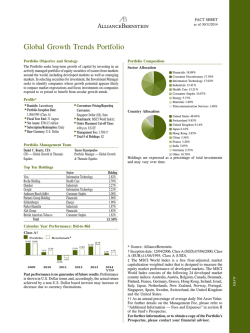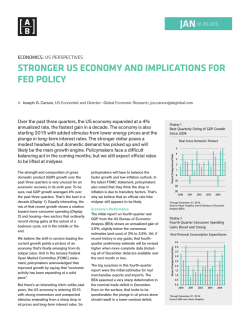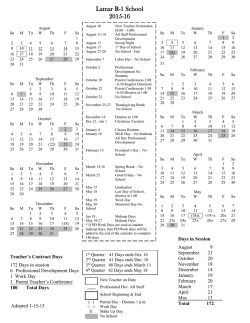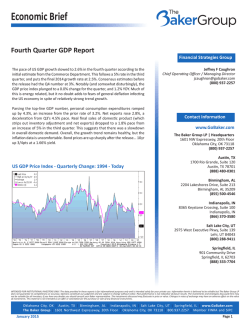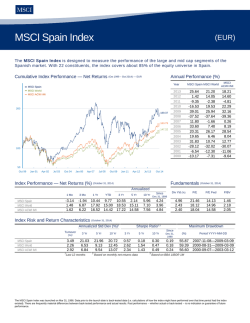
Portfolio Performance
European Growth Services Portfolio Performance Portfolios Underperform as Markets Surge Display 1 Global equity markets continued to rally in the third quarter, as signs of an Risk Appetite Rose in the Third Quarter economic recovery grew clearer. Our portfolios posted strong absolute gains, but underperformed the benchmark as investors punished growth stocks. 3Q:2009 Returns for Selected Indices in Local Currencies (Percent)* 22.4 20.2 16.8 Rally Gathers Momentum from this sector, including Barclays and Equities continued to surge ahead in the HSBC. 15.6 14.8 third quarter (Display 1), as investors Unicredit, Banco Bilbao Vizcaya, and The MSCI Europe Index finished the period Societe Generale. Ja pa n from not owning were financials, including or ld were on the mend. W of the 10 stocks that we suffered most US Additionally—and highly unusually—nine financial system and the global economy Eu Em ro er pe gi ng M ar ke ts grew increasingly confident that the UK (1.4) *Emerging markets represents by MSCI Emerging Markets Index, Europe represented by MSCI Europe, Japan by TOPIX, UK by FTSE All Share, US by S&P 500 and World by MSCI World. Source: FTSE, MSCI Barra, Tokyo Stock Exchange and Alliance up 18%. It has now risen 25.1% since the start of the year and more than 57% since Within industrials, a number of holdings its low point on March 9. also detracted. Outsourcing provider Capita Group underperformed, while BAE Many sectors posted strong gains, though Systems lagged due to investors’ concern financial stocks led the rally (Display 2). about its large pension fund deficit. Economically sensitive sectors produced the largest returns. Display 2 Market Surge Lifted All Sectors 3Q Sector Returns in Euros* 33.0 Financials 22.0 Industrials 21.5 Materials At the sector level, overweight positions in IT and underweight positions in financials Value stocks strongly outperformed detracted from returns. However, growth stocks during the quarter. The underweight positions in the more MSCI Europe Value Index returned 22.2%, defensive utilities and telecom sectors well ahead of the MSCI Europe Growth’s modestly aided performance. rise of 13.7%. Contributors to portfolio returns over the Despite strong absolute returns, our quarter were diverse, but generally came portfolios lagged the market for the from cyclical sectors. quarter. This was primarily the result of 17.4 Telecoms 17.0 Consumer Discretionary 15.4 Healthcare Consumer Staples 14.8 Utilities 14.1 Energy Information Technology 13.0 9.3 As of September 30, 2009 Source: MSCI Barra and Alliance Chartered was among the largest weak stock selection. Sector selection also The portfolios’ largest contributor was individual contributors, as investors began detracted. Volkswagen. The German car manufactur- to realize that prospects were improving er agreed to its takeover of Porsche during for Asian consumer banking revenues. Stock selection was weakest in the the quarter, resulting in a gain in Volkswa- financials and industrials sectors. The gen preferred shares. third-quarter value rally was particularly Global diversified mining group Xstrata rose due to strengthening demand for evident in the financials sector. A number Despite the overall negative impact of ferrochrome and increased production of our portfolios’ largest detractors came financials on the portfolios, Standard volumes of copper, thermal coal, mined nickel and zinc for the first half of 2009. These statements reflect the performance of the majority of accounts. Individual account performance may vary due to a variety of factors, including benchmark, account guidelines, investment vehicle implementation (if any), fees charged and timing of cash flows. 3Q 2009 QUARTERLY REPORT 1 This page is intentionally left blank 2 3Q 2009 QUARTERLY REPORT Growth Equities Market Overview Risk Assets Continue to Rally as Signs of Recovery Proliferate Equity and credit markets rallied further in the third quarter as investors Display 1 Pools of Cash Remain on Sidelines gained confidence that a sustainable economic recovery is under way. We US Money-Market Assets USD Trillions expect a return to modest global economic growth in 2010. As the recovery gains traction, remaining risks and uncertainty are keeping risk premiums 4 elevated and—in our view—attractive. 3 Risk Assets Rally Recovery Is Under Way Risk assets continued to rally in the third The economic recovery—which began in quarter as investors gained confidence that China and other parts of Asia in the the global economy was emerging from second quarter—appeared to gain speed a deep recession and appears on track for a and traction globally in the third quarter. return to modest economic growth. Stocks 2 1 0 2006 2007 2008 1Q:2009 2Q:2009 Source: Haver Analytics and AllianceBernstein rallied globally for the second consecutive Industrial production rebounded sharply quarter; the MSCI World Index rose 17.5% around the world (Display 2). The Global in dollar terms and has recouped about half Manufacturing Purchasing Managers’ its losses from the peaks of 2007. Index (PMI) jumped to its highest level Corporate bonds, commercial mortgage- since early 2008 in August, and exceeded backed securities and other nongovern- 50—the threshold indicating expan- ment debt also rallied as spreads narrowed. sion—for the second consecutive month. Display 2 Manufacturing Has Rebounded Industrial Production 3-Month % Change 30 15 Automakers and other manufacturers are In sum, a sense of normality is returning to boosting production to restock depleted the economy and financial markets. While inventories in anticipation of meeting risk premiums remain high versus historical pent-up demand. 0 (15) Emerging Countries norms, they have receded dramatically Global from their heights at the peak of the Massive doses of coordinated monetary recent crisis. Liquidity is returning, and and fiscal stimulus from governments and credit is becoming cheaper and more central banks around the world have also readily available as markets normalize. provided impetus for the recovery—and Corporate earnings look to have reached there is much more stimulus to come. For bottom after a two-year plunge, and example, of the US$787 billion of positive earnings surprises are increasing. spending and tax cuts promised by the (30) 99 01 budgeted for 2009, with much of the dative monetary policies has supported the balance due in 2010. 05 07 09 Display 3 Consumers Are Repairing Finances Household Debt Burden Percent Obama administration, just a third was The continuation of extremely accommo- 03 Through July 31, 2009 Source: Haver Analytics and AllianceBernstein US UK 60 22 20 rebound in risk assets: by keeping 45 short-term interest rates low, central banks Similarly, while interest rates will eventually are essentially raising the opportunity cost have to rise, major central banks are not 18 30 16 of staying in “safe” assets such as cash likely to dramatically reverse course as long and short-term government bonds. Still, as inflationary pressures remain benign. Projected Projected 14 15 87 94 01 08 87 94 01 08 despite extremely low yields, significant pools of money remain on the sidelines Is the Recovery Sustainable? (Display 1). Reentry of these funds into The global economic recovery has been led the market could extend the current rally. by China and other countries in emerging 3Q 2009 QUARTERLY REPORT US household financial obligations as a percent of disposable income, and UK average mortgage repayment (interest and principal) as a share of average wage; historical data through June 30, 2009; projections through 2010 Source: Haver Analytics, US Federal Reserve and AllianceBernstein 3 Asia. Many observers wonder if the healthier one; the shift toward increased recovery can be sustained if the US domestic demand from China and other consumer continues to save more and large emerging economies is a key spend less. After all, the American ingredient to sustaining global economic consumer accounts for as much as 70% of growth and addressing imbalances. Display 4 Emerging Markets Increasingly Important Share of World GDP US GDP, and in the decade leading up to the recent crisis, the US consumer’s In short, weak consumer spending in the borrowing and consumption binge helped US and other developed markets may not underpin global economic growth. be the roadblock to a sustainable global 20% Emerging Countries 31% US 30% 24% economic recovery that many expect. 24% A Brighter 2010 15% Japan 8% 10% Other 11% Euro Area/UK 27% These concerns are not without foundation. Consumer spending remains depressed by stubbornly high unemploy- We expect emerging-market economies to ment and continued deleveraging. But in continue to lead the recovery in 2010 our view, these concerns are overstated. (Display 5). Overall, we expect global 2000 2008 Source: Haver Analytics and International Monetary Fund economic growth of 3.4%, close to its Display 5 First, consumers in the US and other long-term average. We see US economic A Return to Modest Growth developed markets, while still under growth of 3.5%—higher than the financial stress, have made significant consensus expects but lower than previous progress over the past year in rebuilding periods of recovery following deep their balance sheets. The portion of AllianceBernstein Real GDP Forecasts Percent economic downturns. Japan disposable income eaten up by debt service has fallen sharply in both the US (2.2) Global 1.5 (4.2) UK 2.0 Nevertheless, significant risks and and the UK since the peak of the crisis challenges persist for the global economy (Display 3, previous page). In fact, US and financial markets. Many investors households have cut this ratio to its lowest worry about how governments and central level since 2000. banks around the world will wind down 3.4 (5.5) Euro Area 2.4 programs as their economies recover. Will particularly in the US, as consumers they have the discipline to tighten continue to reduce their debt burden and monetary policy and rein in ballooning save more. As a result, households should fiscal deficits (Display 6)? If not, inflation be in far better financial shape—and more could surge. 2010F (2.5) Canada 2.5 (2.4) US 3.5 1.0 Emerging Countries 6.2 their massive fiscal and monetary stimulus We expect the deleveraging to continue, 2009F (3.6) As of October 1, 2009 Source: AllianceBernstein Display 6 Fiscal Deficits Bear Watching Fiscal Surplus/Deficit Percent of GDP 5 willing to increase their spending—by late 2010, when the benefits of fiscal stimulus The transition will be challenging, but the start to wane. creativity shown by policymakers during 0 the recent crisis gives us comfort in their Second, after a decade of rapid economic ability to adjust policy when necessary. In expansion, emerging-market countries our view, these risks bear close monitoring now contribute more to global GDP than but do not likely pose an economic threat the United States—or the euro area and this year or next. (10) Projected UK (15) the UK combined (Display 4). The upside of continued anxiety about the 4 US (5) The fact that emerging Asian economies economic outlook is that attractive started to rebound in the second quarter opportunities remain for active managers before consumption in developed to add value. We see sizable opportunity countries indicates that the current for equity managers to generate excess recovery in emerging-market economies is returns through stock selection and for driven mainly by domestic demand. In the fixed-income managers to take advantage past, exports were the main driver. In our of the significant return potential in the view, a more balanced global economy is a credit sector. 60 70 80 90 00 10 Historical data through fiscal year 2008; US projections through fiscal year 2019; UK projections through fiscal year 2009 Source: Office of Management and Budget, UK Office for National Statistics and AllianceBernstein 3Q 2009 QUARTERLY REPORT European Growth Services Portfolio Positioning Repositioning Portfolio as Growth Opportunity Develops Display 1 There are signs that Europe is emerging from recession and that earnings Exports Recover from Low Levels growth estimates may start to recover. We have responded by adding to our Euro-Area Exports 140 holdings in technology and financials, funding these additions through the sale of stocks that had started to exhibit less attractive growth characteristics. Outlook Improves as Recession Fades Earnings growth estimates have fallen After the recession in Europe proved to be Historically, after such dips, year-on-year deeper than originally expected, recent estimates have subsequently seen economic data have started to look more substantial growth, indicating a potentially encouraging. Euro-area exports to elevated opportunity in the coming non-euro-area countries rose in the second months (Display 2). substantially in the last six months. quarter, albeit from low levels (Display 1). At the same time, the market’s unwilling- (€ Billions) 130 120 110 100 2007 Positive Prospects for Earnings Growth ness to pay for anticipated earnings demand has started to pick up. There is growth is at a low that is probably mounting evidence that the recession is unsustainable (Display 3). This creates an 60% over, after a number of euro-area elevated opportunity for growth investors. 40% second quarter. 2009 Display 2 Simultaneously, euro-area domestic economies returned to growth in the 2008 Through September 30, 2009 Source: Haver Analytics and AllianceBernstein Year on Year Earnings Growth +54% +52% +50% +34% +40% +34% 20% Portfolio Implications 0% Technology is one of our portfolios’ largest (20)% The same is true in the UK, where the overweights. Over the quarter we added (40)% composite Purchasing Managers’ Index to our position in ASML, which makes (60)% rose to its highest level in August since capital equipment for use in the semicon- 2007, and export volumes have also ductor industry. Our research suggests that increased. the market has underestimated the return (12)% (18)% (29)% (33)% (33)% (44)% 71 74 77 80 83 86 89 92 95 98 01 04 07 Through September 30, 2009 Source: Bank of America Merrill Lynch of demand in the consumer electronics Changes in asset prices have also been industry in the second half of the year. encouraging: after having fallen 20% Display 3 MSCI Europe Value Assigned to Future Growth between mid-2007 and April this year, UK We also initiated a position in Cap Gemini, house prices have confounded expecta- as we believe the company has successfully tions of a protracted decline and have risen reduced its cyclical exposure by outsourc- by 5%. ing much of its cost base. We additionally 100% believe it is well positioned to benefit from 50% Early indications from company meetings that we have been holding since the end a recovery in corporate IT spending over Since end-1969 Expensive Avg. 32% 0% Avg. -1SD 8% the coming year. (50)% of summer are supportive of these more Inexpensive encouraging data. Companies have been We added DNA technology company (100)% reporting that their order books have Qiagen, which our research suggests has (150)% stabilized, that restocking is starting, and attractive growth characteristics. that their outlook is more positive. We also bought shares in Alcatel Lucent, 3Q 2009 QUARTERLY REPORT Avg. +1 SD 56% 71 77 83 89 95 01 07 09 As of September 30, 2009 Source: Datastream, MSCI, Morgan Stanley Research 5 which offers mobile and fixed line network India’s infrastructure needs alone could put services, as our research suggests the significant pressure on supplies of copper company will benefit from increases in and coking coal, which is used to make mobile data usage due to the popularity of steel. smart phones. We partially funded these new positions through the sale of Infineon Meanwhile, both secular trends and and SAP. economic stimulus programs in China are likely to sustain intense demand for New Holdings in Financials materials despite probable short-term We have been modestly increasing our fluctuations. Our investments in Rio Tinto position in financials over the quarter and ArcelorMittal offer exposure to a (Display 4), having been underweight the range of commodities. Display 4 Gradually Closing Our Financials Underweight Active Weights Versus MSCI Europe 0.4% (0.6)% (0.9)% (2.8)% Q2 Q3 European Growth sector for much of the credit crisis. European Concentrated Growth Xstrata is likely to be a key beneficiary of Based on representative European Growth and European Concentrated Growth accounts As of September 30, 2009 Source: MSCI and Alliance The market’s penchant for rewarding the demand we see for copper and coal in weaker companies at the expense of particular. Its exposure to these key stronger ones was most pronounced in commodities and its history of sound financials in the third quarter. Portfolio management and effective cost control holdings such as Credit Suisse underper- create attractive potential for upside Display 5 formed peers that had far less attractive surprise (Display 6). Standard Chartered: Well Diversified Franchise in Growth Markets fundamentals. We repositioned our holdings within the We see exceptional dynamic gap opportu- healthcare sector, establishing a position in nities in high quality capital-markets Shire as our research suggests that the companies such as Credit Suisse, which market underestimates prospects for its have market share advantages, minimal attention deficit disorder and hyperactivity exposure to government bailouts and drugs. rock-solid fundamentals. 1H:2009 Profit by Region Europe + America 4% Africa 8% Hong Kong 17% MESA** 18% Singapore 12% Korea 7% India 16% Other Asia Pac 18% Regional Contribution to Growth (2012E vs 2008) We funded this by selling our position in We also are excited about Standard AstraZeneca, which had outperformed in Chartered, which has strong exposure to recent months, and in Bayer, which posted Asian markets (Display 5), where debt weak earnings. levels are far lower than in the West. In the consumer discretionary sector, we Over the quarter, we initiated a position in closed our position in Greek lottery and Barclays, following a reevaluation of the betting agency OPAP due to worries about growth potential of its acquisition of the implications of new taxes on betting in Lehman Brothers’ US assets. We also Greece. We also exited our position in bought ING Group and added to our Compass Group, after it reported holdings in HSBC. disappointing revenues. 26% 23% 19% 10% 20% 14% HongSingapore India MESA**Africa Hong Singa- KoreaOther Korea OtherAPIndia MESA* Africa Kong pore Kong AP Display 6 Xstrata: Potential for Upside Surprise Alliance 2010 Estimates vs. Consensus Despite the style headwinds that have hurt attractive opportunities. our relative performance, we believe that Return on Equity 165 Looking Ahead and Man Group in favor of these more superior rewards as the market regains From both a secular and a company-specif- equilibrium after both the trauma of the ic standpoint, we are bullish on commodi- recession and the bout of euphoria that ties. Demand from developing nations greeted the first signs of recovery. remains clear despite a tumultuous year. 6 13.8% 136 superior growth fundamentals will reap Opportunities in Commodities (22)% Eur + Eur+ Am*** Am** As of September 30, 2009 *Middle East and South Asia **Europe and Americas Source: Citigroup, CSFB HOLT, company reports and AllianceBernstein; see Disclosures and Important Information. EPS (Pence) We sold out of Hannover Re, Resolution 9% 12.1% Consensus Estimate Alliance Estimate Consensus Estimate Alliance Estimate As of September 30, 2009 Source: Bloomberg and Alliance 3Q 2009 QUARTERLY REPORT © 2009 AllianceBernstein L.P. Note to All Readers: The information contained herein reflects, as of the date hereof, the views of AllianceBernstein L.P. (or its applicable affiliate providing this publication) (“AllianceBernstein”) and sources believed by AllianceBernstein to be reliable. No representation or warranty is made concerning the accuracy of any data compiled herein. In addition, there can be no guarantee that any projection, forecast or opinion in these materials will be realized. Past performance is neither indicative of, nor a guarantee of, future results. Accounts that permit investment practices such as leverage, short sales and derivatives are subject to an increased risk of investment loss and potentially higher performance volatility. The value of investments can fall as well as rise and you may not get back the original amount invested. The views expressed herein may change at any time subsequent to the date of issue hereof. These materials are provided for informational purposes only, and under no circumstances may any information contained herein be construed as investment advice. AllianceBernstein does not provide tax, legal or accounting advice. The information contained herein does not take into account your particular investment objectives, financial situation or needs, and you should, in considering this material, discuss your individual circumstances with professionals in those areas before making any decisions. Any information contained herein may not be construed as any sales or marketing materials in respect of, or an offer or solicitation for the purchase or sale of, any financial instrument, product or service sponsored or provided by AllianceBernstein L.P. or any affiliate or agent thereof. References to specific securities are provided solely in the context of the analysis presented and are not to be considered recommendations by AllianceBernstein. AllianceBernstein and its affiliates may have positions in, and may effect transactions in, the markets, industry sectors and companies described herein. This document is not an advertisement and is not intended for public use or additional distribution. Note to Canadian Readers: This publication has been provided by AllianceBernstein Canada, Inc. or Sanford C. Bernstein & Co., LLC and is for general information purposes only. It should not be construed as advice as to the investing in or the buying or selling of securities, or as an activity in furtherance of a trade in securities. Neither AllianceBernstein Institutional Investments nor AllianceBernstein L.P. provides investment advice or deals in securities in Canada. Note to UK Readers: This document has been provided by AllianceBernstein Limited. Authorised and regulated in the UK by the Financial Services Authority. Note to Japanese Institutional Readers: This document has been provided by AllianceBernstein Japan Ltd. AllianceBernstein Japan Ltd. is a registered investment management company (registration number: Kanto Local Financial Bureau no. 303). It is also a member of Japan Securities Investment Advisers Association and the Investment Trusts Association, Japan. Note to Australian Readers: This document has been issued by AllianceBernstein Australia Limited (ABN 53 095 022 718 and AFSL 230698). Information in this document is intended for wholesale investors only, and is not to be construed as advice. Note to New Zealand Readers: This document has been issued by AllianceBernstein New Zealand Limited (AK 980088). This document is not directed at members of the public. Information in this document is intended for institutional investors only, and is not to be construed as investment advice. Note to Singapore Readers: This document has been issued by AllianceBernstein (Singapore) Ltd. (Company Registration No. 199703364C). The Company is a holder of a Capital Markets Services Licence issued by the Monetary Authority of Singapore to conduct regulated activity in fund management. Note to Hong Kong Readers: This document is issued in Hong Kong by AllianceBernstein Hong Kong Limited, a licensed entity regulated by the Hong Kong Securities and Futures Commission. Bernstein Value Equities (referred to as Bernstein herein), Alliance Growth Equities (referred to as Alliance herein), AllianceBernstein Blend Strategies, AllianceBernstein Fixed Income and AllianceBernstein Alternative Investments (all referred to as AllianceBernstein herein) are units of AllianceBernstein L.P. 3Q 2009 QUARTERLY REPORT 7 This page is intentionally left blank 8 3Q 2009 QUARTERLY REPORT
© Copyright 2024
